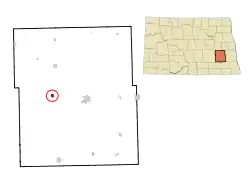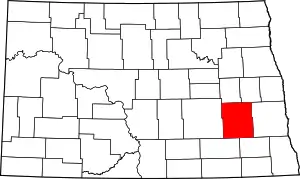Sanborn, North Dakota
Sanborn is a city in Barnes County, North Dakota, United States. The population was 192 at the 2010 census.[5] Sanborn was founded in 1879.
Sanborn, North Dakota | |
|---|---|
 Location of Sanborn, North Dakota | |
 Sanborn, North Dakota Location of Sanborn, North Dakota | |
| Coordinates: 46°56′33″N 98°13′31″W | |
| Country | United States |
| State | North Dakota |
| County | Barnes |
| Area | |
| • Total | 0.60 sq mi (1.55 km2) |
| • Land | 0.60 sq mi (1.55 km2) |
| • Water | 0.00 sq mi (0.00 km2) |
| Elevation | 1,450 ft (442 m) |
| Population | |
| • Total | 192 |
| • Estimate (2019)[3] | 170 |
| • Density | 283.33/sq mi (109.46/km2) |
| Time zone | UTC-6 (Central (CST)) |
| • Summer (DST) | UTC-5 (CDT) |
| ZIP code | 58480 |
| Area code(s) | 701 |
| FIPS code | 38-70380 |
| GNIS feature ID | 1031334[4] |
History
A post office has been in operation at Sanborn since 1879.[6] The city was named in honor of J. N. Sanborn, an early settler. The town was an early contender for the county seat of Barnes County, but lost this role to Valley City in 1880.[7] Its population declined after better roads allowed nearby farmers to trade in Valley City instead.[8]
Geography
Sanborn is located at 46°56′33″N 98°13′31″W (46.942638, -98.225227).[9]
According to the United States Census Bureau, the city has a total area of 0.55 square miles (1.42 km2), all land.[10]
Demographics
| Historical population | |||
|---|---|---|---|
| Census | Pop. | %± | |
| 1890 | 227 | — | |
| 1900 | 259 | 14.1% | |
| 1910 | 390 | 50.6% | |
| 1920 | 391 | 0.3% | |
| 1930 | 343 | −12.3% | |
| 1940 | 366 | 6.7% | |
| 1950 | 324 | −11.5% | |
| 1960 | 263 | −18.8% | |
| 1970 | 255 | −3.0% | |
| 1980 | 237 | −7.1% | |
| 1990 | 164 | −30.8% | |
| 2000 | 194 | 18.3% | |
| 2010 | 192 | −1.0% | |
| 2019 (est.) | 170 | [3] | −11.5% |
| U.S. Decennial Census[11] 2018 Estimate[12] | |||
2010 census
As of the census[2] of 2010, there were 192 people, 73 households, and 58 families living in the city. The population density was 349.1 inhabitants per square mile (134.8/km2). There were 80 housing units at an average density of 145.5 per square mile (56.2/km2). The racial makeup of the city was 99.0% White and 1.0% from two or more races.
There were 73 households, of which 34.2% had children under the age of 18 living with them, 69.9% were married couples living together, 5.5% had a female householder with no husband present, 4.1% had a male householder with no wife present, and 20.5% were non-families. 15.1% of all households were made up of individuals, and 5.5% had someone living alone who was 65 years of age or older. The average household size was 2.63 and the average family size was 2.93.
The median age in the city was 44 years. 26% of residents were under the age of 18; 5.3% were between the ages of 18 and 24; 21.5% were from 25 to 44; 36% were from 45 to 64; and 11.5% were 65 years of age or older. The gender makeup of the city was 51.0% male and 49.0% female.
2000 census
As of the census of 2000, there were 194 people, 74 households, and 54 families living in the city. The population density was 357.0 people per square mile (138.7/km2). There were 80 housing units at an average density of 147.2 per square mile (57.2/km2). The racial makeup of the city was 97.94% White, 1.03% African American, 0.52% Native American, and 0.52% from two or more races.
There were 74 households, out of which 36.5% had children under the age of 18 living with them, 63.5% were married couples living together, 9.5% had a female householder with no husband present, and 25.7% were non-families. 20.3% of all households were made up of individuals, and 8.1% had someone living alone who was 65 years of age or older. The average household size was 2.62 and the average family size was 3.07.
In the city, the population was spread out, with 28.4% under the age of 18, 5.7% from 18 to 24, 27.8% from 25 to 44, 26.8% from 45 to 64, and 11.3% who were 65 years of age or older. The median age was 37 years. For every 100 females, there were 84.8 males. For every 100 females age 18 and over, there were 85.3 males.
The median income for a household in the city was $30,417, and the median income for a family was $33,750. Males had a median income of $26,563 versus $19,375 for females. The per capita income for the city was $13,355. None of the families and 2.6% of the population were living below the poverty line, including no under eighteens and 12.8% of those over 64.
References
- "2019 U.S. Gazetteer Files". United States Census Bureau. Retrieved July 27, 2020.
- "U.S. Census website". United States Census Bureau. Retrieved June 14, 2012.
- "Population and Housing Unit Estimates". United States Census Bureau. May 24, 2020. Retrieved May 27, 2020.
- "US Board on Geographic Names". United States Geological Survey. October 25, 2007. Retrieved January 31, 2008.
- "2010 Census Redistricting Data (Public Law 94-171) Summary File". American FactFinder. United States Census Bureau. Retrieved May 2, 2011.
- "Barnes County". Jim Forte Postal History. Retrieved October 22, 2015.
- Federal Writers' Project (1938). North Dakota, a Guide to the Northern Prairie State,. WPA. p. 281. ISBN 978-1-62376-033-5.
- "Barnes County History 1976: Sanborn". p. 288.
- "US Gazetteer files: 2010, 2000, and 1990". United States Census Bureau. February 12, 2011. Retrieved April 23, 2011.
- "US Gazetteer files 2010". United States Census Bureau. Archived from the original on January 25, 2012. Retrieved June 14, 2012.
- United States Census Bureau. "Census of Population and Housing". Retrieved October 31, 2013.
- "Population Estimates". United States Census Bureau. Retrieved September 10, 2019.
